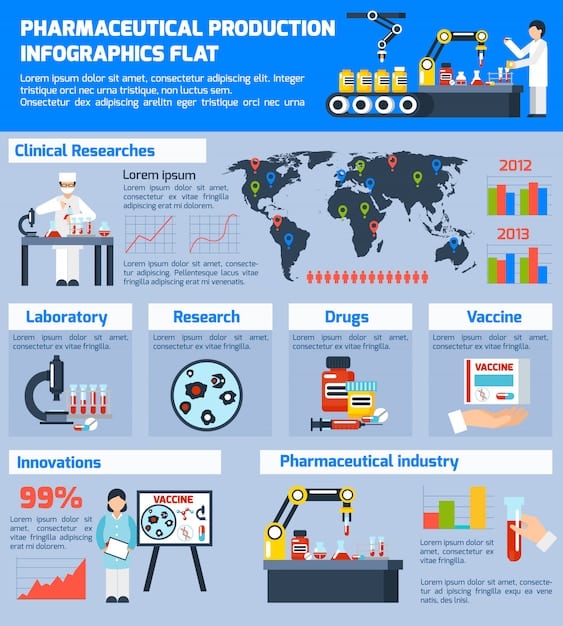Understanding Biotech Investment Risks in the US Market

Biotech investment risks in the US market encompass volatility, regulatory hurdles, clinical trial failures, and funding challenges, all of which can be mitigated through thorough due diligence, diversification, and expert consultation.
Investing in the biotechnology sector offers high potential rewards but also comes with significant risks. Navigating these challenges requires a clear understanding of the factors that can impact your investment and strategies to mitigate potential losses. This article delves into the crucial aspects of biotech investment risks: identifying and mitigating potential losses in the US market.
Deciphering the Biotech Investment Landscape
The biotech industry is characterized by its innovative potential and complex dynamics. Understanding the landscape is the first step in making informed investment decisions. This section provides insights into the major players, market trends, and the overall environment in which biotech companies operate.
To navigate the biotech investment landscape successfully, one must first understand its fundamental nature. This involves acknowledging the unique aspects that differentiate it from other sectors.
Key Players and Market Dynamics
The biotech sector is populated by a diverse range of entities, from emerging startups to established pharmaceutical giants. Each type of player brings its own set of opportunities and risks.
- Emerging Startups: These companies often focus on novel technologies and therapies. They can offer high growth potential but also carry significant risk due to their limited resources and unproven products.
- Mid-Sized Biotech Firms: These companies have typically brought a product or two to market and are continuing to develop their pipelines. They represent a balance between growth potential and stability.
- Large Pharmaceutical Companies: These established players often acquire smaller biotech firms to bolster their pipelines or invest in promising technologies. While generally stable, they can also face risks related to patent expirations and market competition.
Understanding these players requires constant market surveillance as they change over time.

Market Trends and Opportunities
Staying abreast of market trends is crucial for identifying investment opportunities and anticipating potential challenges. Several key trends are shaping the biotech industry today.
- Precision Medicine: The development of therapies tailored to an individual’s genetic makeup is gaining traction. This approach promises more effective treatments but also requires sophisticated diagnostics and data analysis.
- Gene Editing Technologies: CRISPR and other gene editing tools are revolutionizing the treatment of genetic diseases. Investing in companies that are pioneering these technologies could yield significant returns but also carries ethical and regulatory risks.
- Digital Health Integration: The convergence of biotech and digital technologies is creating new opportunities for remote monitoring, personalized health management, and data-driven drug discovery.
These trends have the potential to change much more as time moves forward.
In conclusion, deciphering the biotech investment landscape requires knowledge of its key players and a keen eye on market trends. By understanding market dynamics, investors can make informed decisions and better manage risk.
Identifying Key Biotech Investment Risks
Investing in biotech involves several risks, ranging from clinical trial failures to regulatory hurdles. Identifying these risks is essential for protecting your investment and achieving long-term success. This section will outline the primary risks associated with biotech investments.
Investing wisely begins with understanding the potential pitfalls that may lie ahead. By recognizing these, you can take proactive steps to protect your investments and maximize your chances of success.
Clinical Trial Risks
Clinical trials are a critical phase in the development of new drugs and therapies. However, they also represent a significant source of risk for biotech investors.
Clinical trials themselves have significant risks attached to them.
- Efficacy Failure: A drug may fail to demonstrate the desired therapeutic effect in clinical trials, leading to the abandonment of the project and significant losses for investors.
- Safety Concerns: Unexpected side effects or adverse events can halt a clinical trial and damage a company’s reputation, resulting in a decline in stock value.
- Trial Design Flaws: Poorly designed clinical trials may produce inconclusive results, delaying or preventing regulatory approval.
Without understanding these risks, an investor can easily lose all of their profits.
Regulatory Risks
The biotech industry is heavily regulated, and compliance with regulatory requirements is essential for bringing new products to market. Regulatory risks can significantly impact the timelines and costs associated with drug development.
The following can change how much money can be brought in by a company.
- Approval Delays: Regulatory agencies such as the FDA may delay or reject approval of a new drug due to concerns about safety, efficacy, or manufacturing quality.
- Changing Regulations: Shifts in regulatory policies can create uncertainty and require companies to adapt their strategies, potentially increasing costs and delaying product launches.
- Pricing Pressures: Government and private payers are increasingly scrutinizing drug prices, which can limit the profitability of new therapies.
These regulatory risks should be on the mind of anyone making transactions in the field.
Financial Risks
Biotech companies often require substantial capital to fund research and development, clinical trials, and commercialization efforts. Financial risks can arise from difficulties in raising capital or managing cash flow.
Without money, companies cannot continue.
- Funding Shortfalls: Biotech companies may struggle to secure funding through venture capital, public offerings, or partnerships, leading to delays in development or even bankruptcy.
- Cash Burn Rate: High operating expenses and limited revenue can deplete a company’s cash reserves, forcing it to seek additional financing on unfavorable terms.
- Market Volatility: Economic downturns or changes in investor sentiment can impact biotech stock prices, making it difficult for companies to raise capital and sustain operations.
In conclusion, identifying these investment risks enables informed decision-making, better risk mitigation strategies, and increased opportunities for success.
Strategies for Mitigating Potential Losses
Mitigating potential losses in biotech investing requires a proactive and diversified approach. By implementing these strategies, investors can reduce their exposure to risk and improve their chances of achieving long-term returns. This section outlines actionable steps to safeguard your biotech investments.
Mitigating risk is not about eliminating it entirely, but about reducing the potential negative impact it can have on investments. A well-thought-out strategy can help protect your portfolio and increase your chances of success.
Diversification
Diversification is a fundamental risk management strategy that involves spreading investments across a variety of assets. In the context of biotech investing, this means allocating capital to multiple companies, therapeutic areas, and stages of development.
How can one diversify?
- Invest in Multiple Companies: Rather than putting all your eggs in one basket, spread your investment across several biotech companies. This reduces the impact of any single company’s failure on your overall portfolio.
- Diversify Therapeutic Areas: Invest in companies that are developing therapies for different diseases and conditions. This helps to mitigate the risk associated with specific therapeutic areas becoming obsolete or facing regulatory challenges.
- Consider Different Stages of Development: Allocate capital to companies at various stages of development, from early-stage research to late-stage clinical trials and commercialization.
This approach is known as modern portfolio, and diversification is core to it.

Due Diligence
Thorough due diligence is essential for assessing the potential risks and rewards of a biotech investment. This involves conducting in-depth research on the company, its technology, and the market environment.
The best way to ensure the viability of an investment is to do your homework.
- Evaluate the Science: Assess the scientific validity and novelty of the company’s technology. Review published research, patent filings, and expert opinions to determine the potential of the technology.
- Assess the Management Team: Evaluate the experience and track record of the company’s management team. A strong and experienced management team is more likely to navigate the challenges of drug development and commercialization successfully.
- Analyze the Financials: Review the company’s financial statements, including its cash burn rate, funding sources, and debt levels. This will help you assess the company’s ability to fund its operations and meet its financial obligations.
Due diligence will protect investors from poor decisions.
Hedging Strategies
Hedging strategies can be used to offset potential losses in biotech investments. These strategies typically involve using financial instruments such as options or short selling to protect against downside risk.
There are also different methods when it comes to hedging.
- Options Trading: Buy put options on biotech stocks to protect against potential price declines. Put options give you the right, but not the obligation, to sell the stock at a specified price.
- Short Selling: Sell short shares of a biotech company that you believe is overvalued or facing significant risks. This allows you to profit from a decline in the stock price.
- Inverse ETFs: Invest in inverse exchange-traded funds (ETFs) that are designed to increase in value when the biotech sector declines.
Implementing these diverse steps can significantly mitigate potential losses in biotech ventures, enhancing the resilience and profitability of one’s investments.
The Role of Regulatory Agencies
Regulatory agencies, such as the FDA in the United States, play a crucial role in the biotechnology industry. They are responsible for ensuring the safety and efficacy of new drugs and therapies before they are made available to the public. Understanding the role of these agencies is essential for managing biotech investment risks.
These agencies have an important job that requires great effort.
FDA Approval Process
The FDA approval process can impact the outcome of the industry.
- Preclinical Research: Companies must conduct laboratory and animal testing to assess the safety and efficacy of a new drug before it can be tested in humans.
- Clinical Trials: Drugs are tested in three phases of clinical trials to evaluate their safety, efficacy, and optimal dosage.
- New Drug Application (NDA): If clinical trials are successful, the company submits an NDA to the FDA, which reviews the data and decides whether to approve the drug.
These phases are a necessary process for determining whether or not these methods will go public.
Impact on Investment Decisions
How should regulatory agencies affect our decisions?
- Approval Timelines: FDA approval timelines can be lengthy and unpredictable, which can impact the profitability of biotech investments.
- Regulatory Hurdles: Companies may face regulatory hurdles such as requests for additional data, which can delay or prevent approval of a new drug.
- Post-Market Surveillance: Even after a drug is approved, the FDA continues to monitor its safety and efficacy, and may require additional studies or labeling changes.
These impacts should be on the mind of the investor, as it can change decisions.
Navigating Regulatory Challenges
How can investors navigate regulations?
- Stay Informed: Keep abreast of regulatory developments and FDA guidelines to anticipate potential challenges and opportunities.
- Seek Expert Advice: Consult with regulatory experts who can provide guidance on navigating the FDA approval process and complying with regulatory requirements.
- Evaluate Regulatory Strategy: Assess the company’s regulatory strategy and its ability to successfully navigate the FDA approval process.
These strategies can help investors to avoid financial collapse because of government regulations.
The role of regulatory agencies is crucial in the biotech industry, and understanding their impact is essential for managing investment risks. By staying informed, seeking expert advice, and evaluating regulatory strategies, investors can make more informed decisions and improve their chances of success.
Case Studies of Successful and Unsuccessful Biotech Investments
Analyzing case studies of both successful and unsuccessful biotech investments can provide valuable insights into the factors that drive investment outcomes. This section presents several real-world examples that highlight the importance of due diligence, risk management, and strategic decision-making.
This analysis creates a better understanding of key factors that can bring profits.
Successful Biotech Investments
Some examples of successful endeavors.
- Gilead Sciences: Gilead’s successful development and commercialization of antiviral drugs for HIV and hepatitis C have generated billions of dollars in revenue and created significant value for investors.
- Regeneron Pharmaceuticals: Regeneron’s innovative pipeline of antibody-based therapies has led to the approval of several blockbuster drugs, including Eylea and Dupixent.
- Vertex Pharmaceuticals: Vertex’s development of targeted therapies for cystic fibrosis has transformed the treatment of the disease and created substantial returns for investors.
These examples highlight the potential rewards of biotech investing and the importance of identifying companies with innovative technologies, strong management teams, and clear regulatory pathways.
Unsuccessful Biotech Investments
Now, for some examples of ventures that were not successful.
- Dendreon Corporation: Dendreon’s prostate cancer vaccine, Provenge, faced challenges related to manufacturing complexity, high cost, and limited efficacy, leading to disappointing sales and eventual bankruptcy.
- Mannkind Corporation: Mannkind’s inhaled insulin product, Afrezza, failed to gain widespread adoption due to concerns about its safety and effectiveness, resulting in significant losses for investors.
- Theranos: Theranos, a blood-testing company, collapsed after it was revealed that its technology was not accurate or reliable, leading to criminal charges and a complete loss of investor capital.
These examples highlight the risks of investing in companies with unproven technologies, flawed business models, or questionable ethical practices.
By analyzing these experiences, investors can learn valuable lessons about the importance of risk management and the potential pitfalls of biotech investing. These examples reinforce the need for thorough evaluation and strategic decision-making to navigate the challenges of this complex industry.
Future Trends in Biotech Investment
The biotech industry is constantly evolving, and emerging trends are shaping the future of investment opportunities and risks. Understanding these trends is essential for positioning your portfolio for long-term success. This section highlights several key trends that are expected to impact biotech investing in the coming years.
The future offers possibilities, but the right information is needed to know just what possibilities are available to us.
Artificial Intelligence and Machine Learning
How will automation play a role?
- Drug Discovery: AI and machine learning algorithms are being used to analyze vast amounts of data, predict drug targets, and accelerate the drug discovery process.
- Clinical Trial Optimization: AI can help to optimize clinical trial design, identify eligible patients, and predict trial outcomes, improving the efficiency and success rates of clinical trials.
- Personalized Medicine: AI is being used to analyze patient data and develop personalized treatment plans based on individual genetic profiles and disease characteristics.
Increased efficiency can be made through its use and make things easier for new companies.
Advancements in Gene Therapy
New innovations continue to develop in this part of the industry.
- CRISPR-Based Therapies: CRISPR gene editing technology is being used to develop therapies for genetic diseases, with promising results in clinical trials.
- Adeno-Associated Virus (AAV) Vectors: AAV vectors are being used to deliver gene therapies to specific cells and tissues, improving the safety and efficacy of gene therapies.
- RNA-Based Therapies: RNA interference (RNAi) and messenger RNA (mRNA) technologies are being used to develop therapies that target specific genes or proteins involved in disease.
These advancements improve the ability the industry has to make a difference.
Increased Focus on Preventative Medicine
What new initiatives will be pushed by corporations?
- Early Detection Technologies: Technologies for detecting diseases at an early stage are becoming increasingly important, allowing for earlier intervention and improved outcomes.
- Personalized Prevention Strategies: Personalized prevention strategies are being developed based on an individual’s genetic and lifestyle factors, helping to reduce the risk of disease.
- Digital Health Solutions: Digital health tools are being used to monitor health, promote healthy behaviors, and prevent the onset of chronic diseases.
Overall health pushes are good for the consumer and for the economy as a whole.
Looking ahead, these new initiatives can drive new investment opportunities in biotech.
| Key Point | Brief Description |
|---|---|
| 🧪 Clinical Trial Risks | Potential failures in efficacy, safety, or design can severely impact investment returns. |
| 📜 Regulatory Hurdles | Approval delays and changing regulations can increase costs and delay product launches. |
| 💰 Financial Risks | Funding shortfalls and market volatility can threaten a biotech company’s financial stability. |
| 🛡️ Mitigation Strategies | Diversification, due diligence, and hedging can reduce potential losses in biotech investments. |
FAQ
▼
The primary risks include clinical trial failures, regulatory challenges, financial instability, and market volatility. Each can significantly impact investment returns.
▼
Diversifying across multiple companies, therapeutic areas, and stages of development reduces the impact of any single failure on your portfolio.
▼
Thorough due diligence helps assess the company’s science, management team, and financials, enabling more informed investment decisions and risk evaluation.
▼
Regulatory agencies like the FDA can affect approval timelines and impose hurdles, influencing the costs and profitability of biotech ventures and investments.
▼
Keep an eye on advancements in AI-driven drug discovery, gene therapy, and preventative medicine. They promise to revolutionize the future of biotech and investment.
Conclusion
Navigating the intricacies of biotech investments requires understanding key risks, implementing mitigation strategies, and staying informed about future trends. By combining thorough analysis of these elements, investors can better position themselves for greater opportunities and mitigate risks, maximizing chances for success in the US market.





